Statement on Monetary Policy – February 2006 International and Foreign Exchange Markets
Overseas markets
Official interest rates
All major central banks around the world, with the exception of the Bank of Japan, have now begun the process of normalising interest rates from the unusually low levels reached earlier this decade (Graph 12). In the US, the Federal Reserve has raised the federal funds rate from its record low level of only 1 per cent in 2003 to a more normal level of 4½ per cent in a sequence of 14 consecutive tightenings of 25 basis points (Graph 13). Real policy rates are now more in line with historical averages, following several years of negative real rates. Current market expectations are that, with interest rates now at more normal levels, the Fed will soon pause in the current tightening cycle to assess whether incoming data about the economic cycle and inflation warrant a tighter stance in monetary policy settings (Table 2).
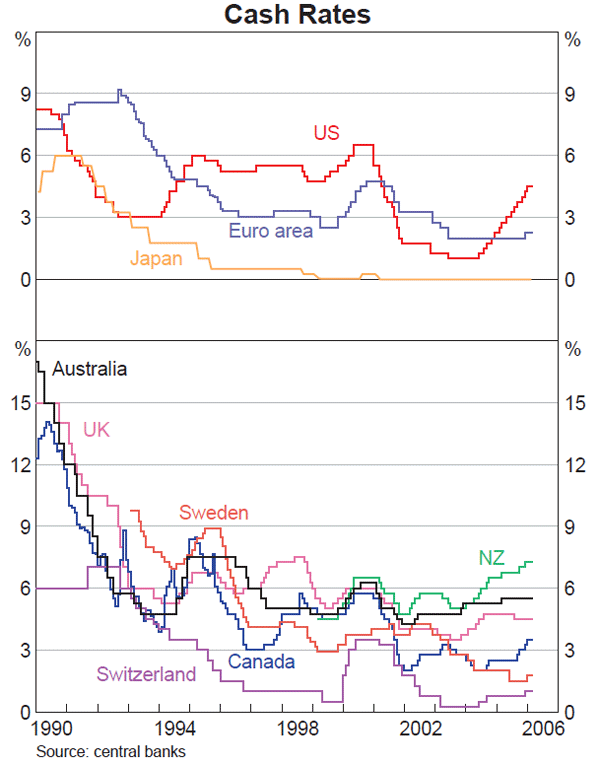
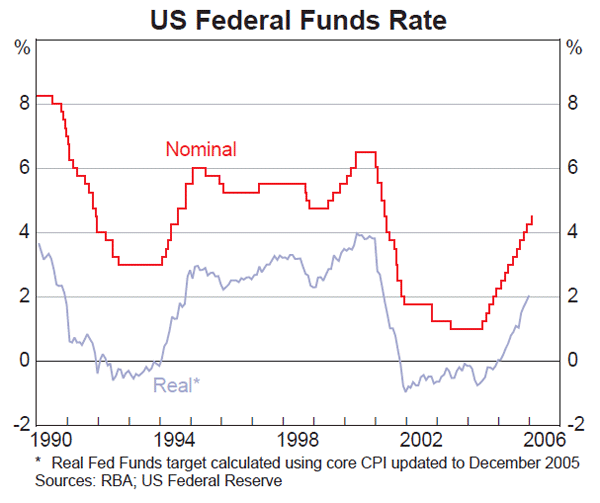
| Current level Per cent |
Most recent change |
Expectations for next 6 months |
|
|---|---|---|---|
| United States | 4.50 | ↑ Jan 06 | ↑ 50 bps |
| Euro area | 2.25 | ↑ Dec 05 | ↑ 50 bps |
| Japan | 0.00 | ↓ Mar 01 | no change |
| United Kingdom | 4.50 | ↓ Aug 05 | no change |
| Canada | 3.50 | ↑ Jan 06 | ↑ 50 bps |
|
Sources: central banks; Bloomberg; Reuters |
|||
European central banks have lagged behind the US in restoring normal interest rates, reflecting the fact that economic conditions in Europe have, until recently, been relatively subdued. The European Central Bank (ECB) made its first policy tightening in December 2005, raising rates by 0.25 per cent to 2.25 per cent. Markets currently have two additional rate rises to 2.75 per cent priced in over the next six months. Elsewhere in Europe, rates have also recently been raised from historic lows in Denmark, Sweden and Switzerland.
The Bank of England had not reduced its policy rate as much as some other developed economies earlier in the decade, and had a relatively brief tightening cycle from late 2003 until mid 2004 during which the policy rate was raised by 125 basis points. It has since lowered its policy rate by 25 basis points to 4½ per cent in August 2005, reflecting a slowdown in the economy. The Reserve Bank of New Zealand (RBNZ) continued its monetary tightening in 2005, raising the official cash rate by ¾ percentage point over the year, to 7.25 per cent, bringing the cumulative tightening to 225 basis points since early 2004. Following recent signs of a slowdown in the economy, the market expects that the RBNZ's tightening cycle is at an end. The Bank of Canada also has continued on its gradual tightening path that commenced in 2004, raising its policy rate at its December 2005 and January 2006 meetings to the current level of 3.50 per cent. The accompanying statement indicated further modest rate increases would probably be necessary.
Policy interest rates in Japan have been at zero for more than five years now. Monetary policy in Japan has been exceptionally easy to help offset some of the deep-rooted structural problems in the economy that came to the fore during the economic downturn that began in the early 1990s. Part of the Bank of Japan's monetary policy has been to provide an unusually large amount of liquidity to banks and the recent policy debate has revolved around when this policy will end, given that the financial system is now in better health and that economic recovery has taken hold. Markets expect that this will occur in the next few months, but that the subsequent, and more important, step in the normalisation process – beginning to raise official interest rates – will not occur in 2006.
Markets are quite anxious about any tightening by the Bank of Japan because a lot of speculative activity, mainly borrowing short-term funds in low-interest countries to invest in higher-yielding assets, has been funded by zero cost money from Japan. Hedge funds have been particularly active in this so-called ‘carry’ trade and it is possible that they may respond to the start of tightening by the Bank of Japan by quickly liquidating holdings of bonds and equities that have been funded in this way.
In the rest of Asia, policy rates are also being gradually raised from historically low levels in most countries. The largest increases have been in Indonesia, where there has been a cumulative tightening of 425 basis points, to 12¾ per cent since July 2005. In contrast, in several other emerging-market economies, such as Brazil, Mexico and Turkey, rates have been lowered in recent months as inflation pressures have eased and, in the case of the first two, the domestic economy has slowed in response to earlier monetary policy tightening.
Bond yields
Yields on the major economies' long-term government debt have declined significantly over the past decade and remain at unusually low levels by historical standards despite recent rises in short rates (Graph 14). While the low level of yields is in part due to a step down into a low-inflation environment over the past decade or so, this alone does not explain the decline in real yields that has also been evident in recent years.
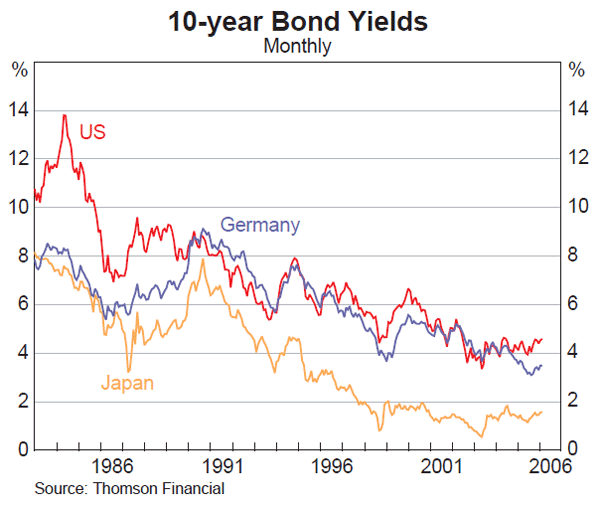
In the US, yields on government bonds have fluctuated broadly within a narrow range of 4 to 4½ per cent over the past two years. As the current tightening cycle has progressed, the spread between long-term yields and short rates has continually narrowed, so that the US yield curve is now effectively flat (Graph 15). The recent stability of longer-term yields stands in contrast to past episodes of monetary tightening, during which long-term yields have tended to rise by at least as much as short rates in the early stages of the cycle.
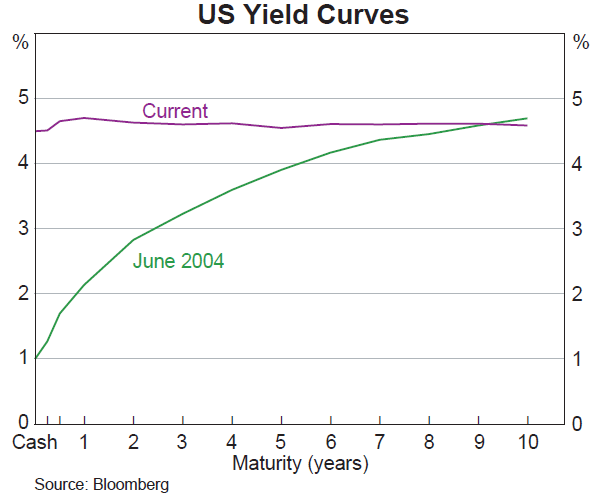
German yields reached a post-War low of 3 per cent in late 2005, a move also reflected elsewhere in the euro area. Against a background of relatively steady US yields, this caused the bond spread between the two countries to widen to around 125 basis points, the largest it has been since the late 1990s. The widening in the spread with US yields reflected the less favourable economic outlook in Europe through much of 2005.
Japanese government bond yields remain at very low levels, generally trading a relatively tight range of just ±50 basis points around 1½ per cent since 1998. Over the second half of 2005, an improvement in the country's economic outlook and the related sharp rise in Japanese equities gave rise to a small increase in yields on government debt.
The downward trend evident in yields in the major three markets has also occurred in other developed countries (Graph 16), as well as a number of countries in east Asia, where long-term yields on local currency bonds are even trading below those in the US.
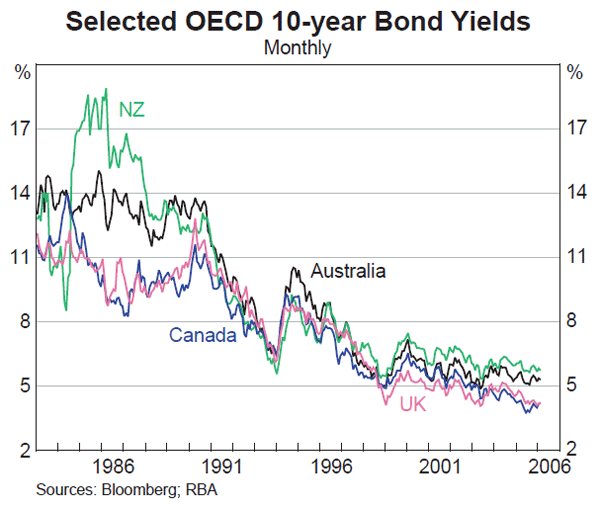
The low level of global bond yields is not fully explained by well-anchored inflation expectations or improved central bank credibility. It appears that an excess of global saving over investment (in an ex ante sense) has also been an important contributory factor. Additionally, in some countries, most notably the United Kingdom, changes to the rules governing the way that pension funds account for their liabilities have led to a surge in demand for very long-dated bonds. The demand for inflation-protected long bonds has been particularly strong, pushing real yields to an all time low of just half of one percentage point.
Not only are global bond yields low, but volatility in yields has been at its lowest in several decades. Over the calendar year 2005, yields on US government bonds moved in a range of only 77 basis points, the narrowest in the past three decades (Graph 17). Similarly, day-to-day fluctuations have been much smaller than in previous years (Graph 18).
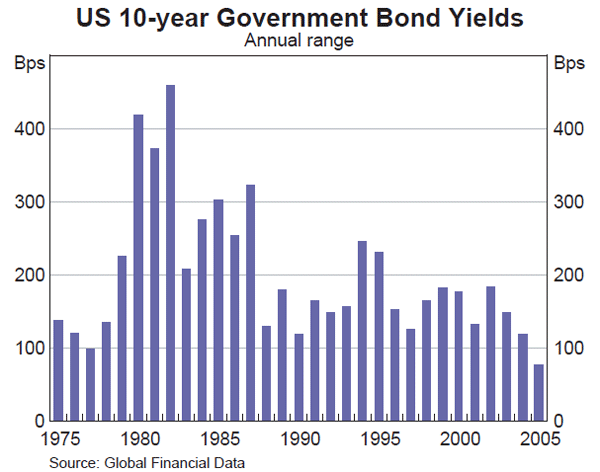
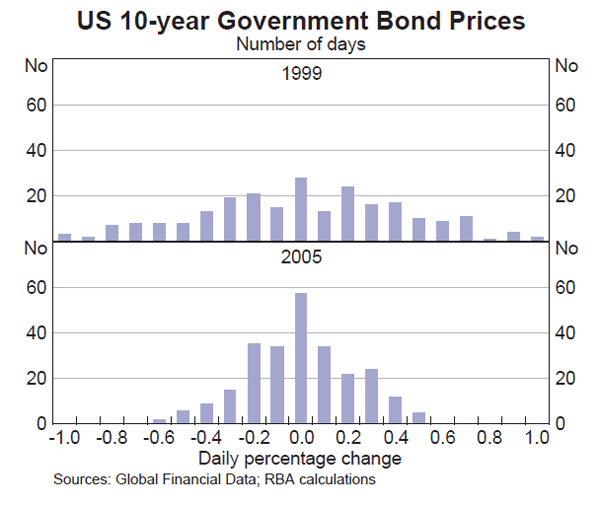
The low level of yields on government bonds has prompted a ‘search for yield’ in recent years, creating demand for more risky assets. Consequently, risk premia on corporate and emerging-market bonds have declined sharply to relatively low levels (Graph 19).
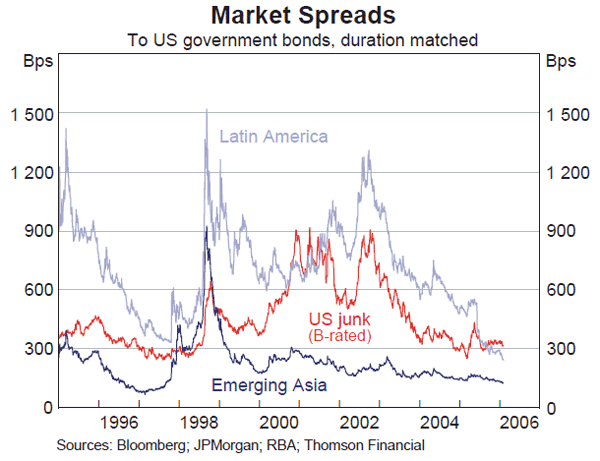
Equities
Global share markets generally posted solid gains for the third consecutive year in 2005 (Table 3). Although volatility in equity markets was also less than usual in 2005, it has not been at the record lows seen in bond markets.
| Since 2000 peak |
Since 2003 trough |
2005 | Since previous Statement |
|
|---|---|---|---|---|
| United States | ||||
| – Dow Jones | −7 | 44 | −1 | 4 |
| – S&P 500 | −17 | 58 | 3 | 4 |
| – NASDAQ | −55 | 78 | 1 | 6 |
| Euro area | ||||
| – STOXX | −26 | 107 | 23 | 12 |
| United Kingdom | ||||
| – FTSE | −17 | 74 | 17 | 7 |
| Japan | ||||
| – TOPIX | −5 | 117 | 44 | 13 |
| Canada | ||||
| – TSE 300 | 3 | 88 | 22 | 11 |
| Australia | ||||
| – ASX 200 | 43 | 79 | 18 | 8 |
|
Source: Bloomberg |
||||
The US market rose less than most last year despite strong corporate earnings, possibly because of rising official interest rates (Graph 20). Although the US price-to-earnings (P/E) ratio declined further in 2005, it remains above long-term average levels suggesting that the effects of the bubble have not yet been totally removed from the market. The current level of share prices remains 17 per cent below the peak six years ago.
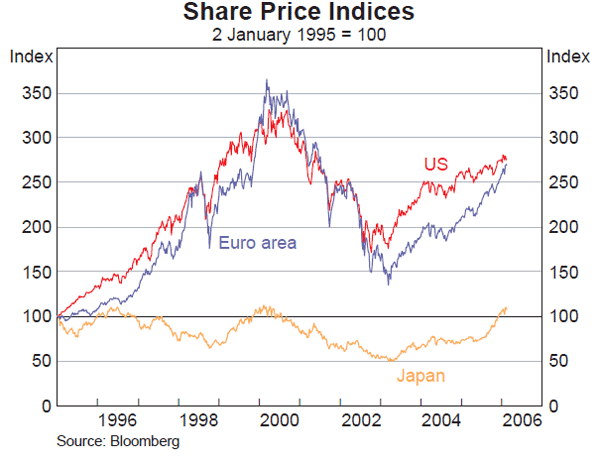
Equity markets in Europe performed strongly throughout 2005, with the Euro STOXX rising by 23 per cent. Aggressive cost cutting and restructuring has helped European firms record stronger earnings growth than in the United States, despite relatively lacklustre overall economic performance.
After a relatively slow start to 2005, Japanese share prices significantly outperformed other major equity markets in the second half of the year on optimism about the strength of the Japanese economy. Over the year as a whole they were up 44 per cent. However, Japanese share prices are still 40 per cent below their peak in 1989.
Share prices in emerging Asia also rose in 2005 to their highest levels since August 2000 (Graph 21). The strongest gains of more than 50 per cent were in the Korean stock market reflecting a recovery in domestic demand and improved corporate profitability. Notably, the strong foreign inflows into Korean equities observed over recent years slowed sharply in 2005, implying that gains were largely domestically driven. One area of weakness was China's foreign currency-denominated B-shares, which are available to both foreign and domestic investors. They fell by 18 per cent in 2005 on uncertainty regarding the government's disposal of its shares in state-owned enterprises and on disappointing corporate earnings. Nevertheless, in a sharp turn-around since then, these shares are up by around 50 per cent over 2006 to date, following news that companies may be permitted to convert the foreign currency-denominated shares into local currency-denominated shares.
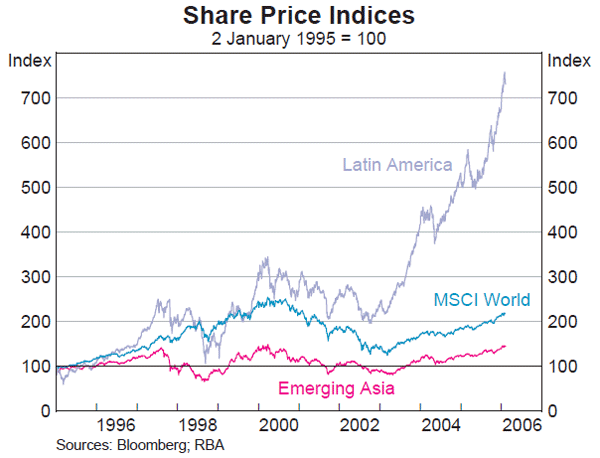
Latin American share prices also continued to build on a sharp rally that has been in place since 2003. Share prices in Latin America have more than trebled since that time, buoyed by a more stable economic and political outlook for the region, coupled with rising commodity prices.
Exchange rates
The notable development in global currency markets in 2005 was that, contrary to widespread predictions, the US dollar rose rather than fell against the major currencies (Graph 22, Table 4). The US dollar had fallen over the previous three years, unwinding a good part of the rise that took place in the second half of the 1990s and in the early part of this decade. But with the US economy performing better than most last year and interest rates in the US again at levels well above those in Europe and Japan, the US dollar again found favour among investors. The US dollar's level relative to other major currencies is currently around long-run average levels.
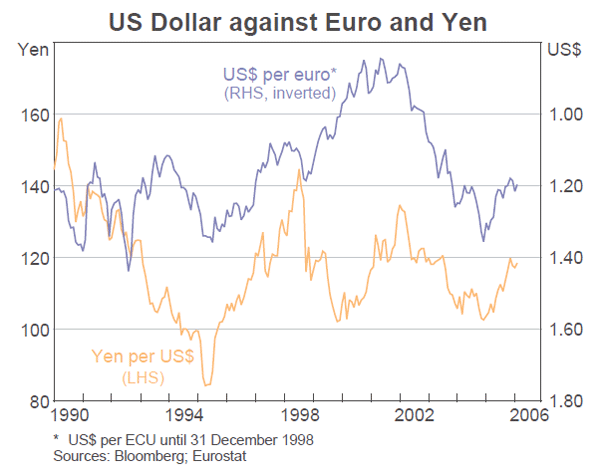
| Since USD peak Jan 2002 |
2005 | Since last Statement |
|
|---|---|---|---|
| South Africa | −46 | 12 | −8 |
| New Zealand | −37 | 5 | 1 |
| Australia | −30 | 6 | −1 |
| Canada | −28 | −3 | −3 |
| Euro area | −28 | 14 | −1 |
| Sweden | −28 | 19 | −5 |
| South Korea | −26 | −2 | −7 |
| Switzerland | −24 | 15 | −1 |
| UK | −19 | 11 | 0 |
| Japan | −11 | 15 | 1 |
| Singapore | −11 | 2 | −4 |
| Indonesia | −11 | 6 | −8 |
| Thailand | −10 | 5 | −3 |
| Brazil | −10 | −12 | −1 |
| India | −8 | 4 | −4 |
| Taiwan | −7 | 3 | −4 |
| China | −3 | −2 | 0 |
| Malaysia | −2 | −1 | −1 |
| Philippines | 1 | −6 | −5 |
| Mexico | 15 | −5 | −2 |
| Majors TWI | −24 | 8 | −1 |
| Broad TWI | −15 | 3 | −2 |
|
Source: RBA |
|||
Many commentators believe that the US dollar should fall sharply further because of that country's current account deficit, but such views may be underestimating the importance of the other half of the balance of payments – namely the capital account. In a world of globalised capital markets, capital flows seeking to take advantage of actual and perceived differences in rates of return across countries can be more powerful than trade positions for currency markets.
Market forces seem to be working to push up Asian currencies against the US dollar, but these have been resisted strongly by central banks in the region. Many countries have engaged in very large-scale foreign exchange intervention to limit any tendency for their currencies to appreciate (Graph 23). Over the past three years, Asian countries (including Japan) have undertaken US$1,250 billion of intervention, a figure unprecedented in history and very large relative to the size of these countries' economies. As a result, Asian currencies have on average appreciated only a little against the US dollar over recent years, and current exchange rates for the most part remain well below pre-crisis levels (Graph 24). The Japanese and most other Asian central banks scaled back sharply their rate of reserves accumulation in 2005 but the People's Bank of China has maintained its level of activity. It is not surprising, therefore, that there remains intense interest in global financial markets in Chinese exchange rate arrangements.
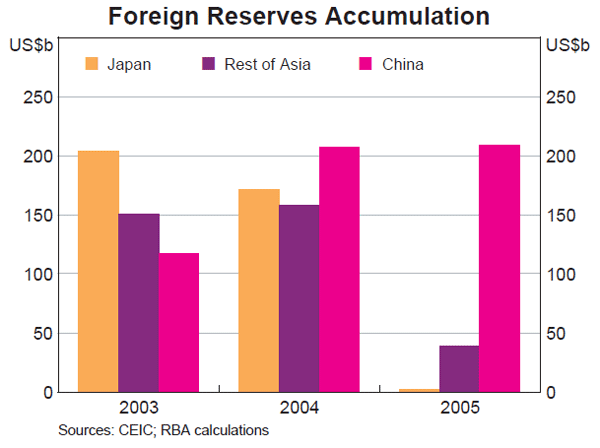
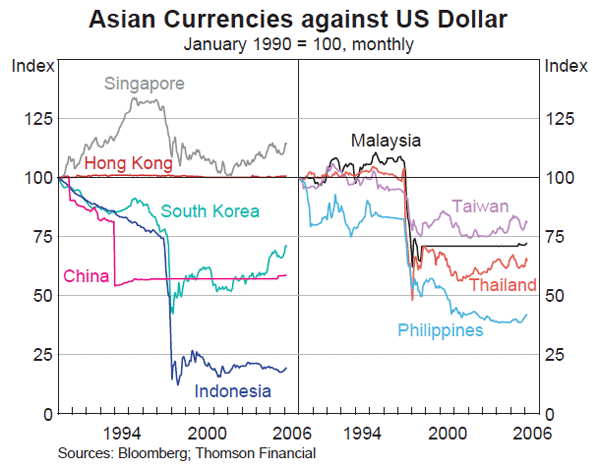
Since the revaluation of the Chinese renminbi in the middle of last year, there has been negligible change in the currency against the US dollar. Pricing in the non-deliverable forward market indicates that markets expect the renminbi to be around 4½ per cent higher against the US dollar in 12 months.
Latin American currencies generally appreciated against the US dollar in 2005, with the Brazilian real rising by 15 per cent reflecting the ongoing improvement in economic prospects there.
Australian dollar
The Australian dollar traded in a narrow range over 2005; on a trade-weighted basis, its range was the lowest recorded in the post-float era (Graph 25). While the domestic currency depreciated modestly against the US dollar and many Asian currencies from the beginning of 2005, gains against European currencies, the Japanese yen and the British pound were broadly offsetting (Table 5). In recent months the Australian dollar has traded in a relatively narrow range around US75 cents, a little above its post-float average of US71 cents. In trade-weighted terms, it is around 63, compared with a post-float average of 58.1 (Graph 26). Box B discusses movements in the Australian dollar over a longer horizon.
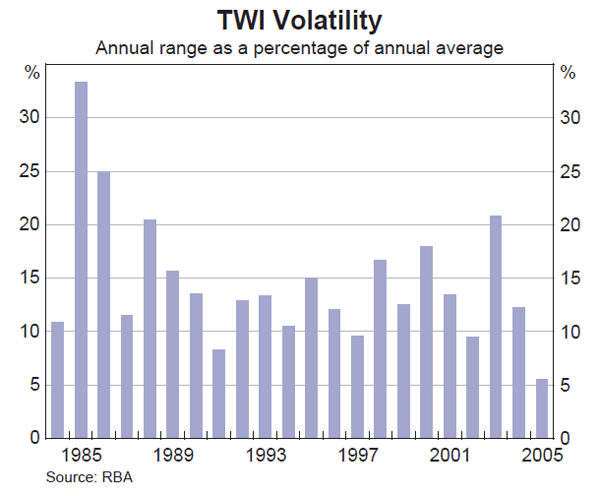
| Since April 2001 trough |
2005 | Since last Statement |
|
|---|---|---|---|
| Philippines | 59 | −11 | −5 |
| US | 53 | −6 | 1 |
| Taiwan | 50 | −3 | −3 |
| China | 49 | −8 | 0 |
| PNG | 44 | −7 | 1 |
| Japan | 44 | 7 | 1 |
| Singapore | 38 | −4 | −3 |
| Indonesia | 36 | −1 | −7 |
| UK | 25 | 5 | 1 |
| South Africa | 16 | 6 | −7 |
| Switzerland | 15 | 9 | 0 |
| Sweden | 14 | 13 | −4 |
| Euro | 13 | 8 | 0 |
| Canada | 11 | −9 | −2 |
| South Korea | 10 | −8 | −7 |
| New Zealand | −9 | −1 | 2 |
| TWI | 34 | −1 | −1 |
|
Source: RBA |
|||
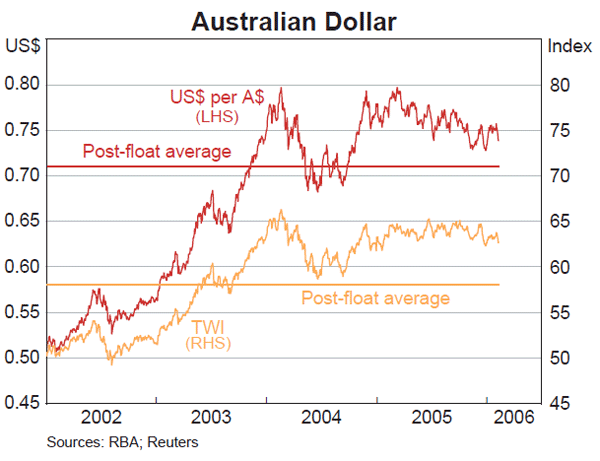
The relative stability of the currency in 2005 seemed to be the outcome of two offsetting forces. Strong commodity prices – particularly coal, iron ore and base metals – and the resulting rise in the terms of trade have been a positive influence. On the other hand, the narrowing of interest differentials relative to some overseas countries has reduced demand for the Australian dollar. Most notably, the short-term interest differential with the United States has narrowed from 300 basis points at the start of 2005 to 100 basis points currently. In addition, there appears to have been some diversion to New Zealand of international money previously flowing to Australia as the cash rate in New Zealand was raised to 7.25 per cent. This was most evident in uridashi issuance, with A$-denominated issuance declining sharply and NZ$-denominated issuance rising markedly.
Investor sentiment towards the Australian dollar remains positive as evidenced by the continuing net long speculative positions in Australian dollar futures on the Chicago Mercantile Exchange (Graph 27). However, the size of these positions declined noticeably over the course of 2005.
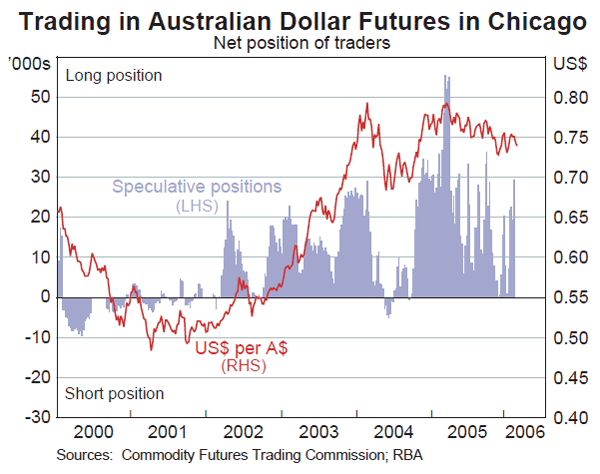
Over recent years, the Reserve Bank has been buying foreign exchange to replenish reserves sold during intervention to support the exchange rate between 1997 and 2001. It bought about $7½ billion of foreign exchange in each of 2003 and 2004, but over the past year net purchases were scaled back to around half that amount. This reflected the slightly softer exchange rate and the reduced imperative to add further to reserves given the relatively comfortable level of existing holdings. Net reserves are currently around $28½ billion. In addition to this, the Bank also holds about $30 billion of foreign exchange under swap arrangements undertaken for domestic liquidity operations.